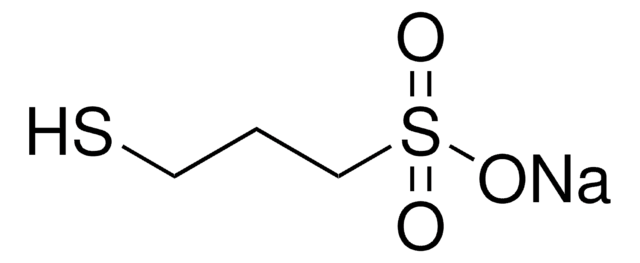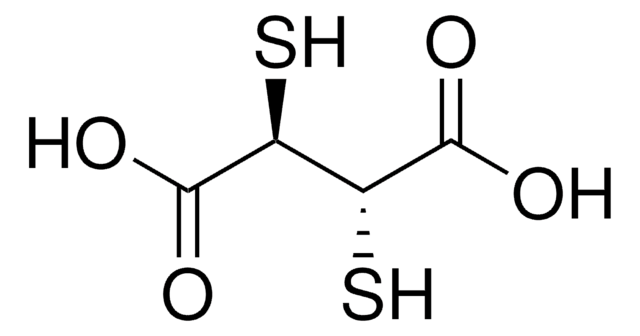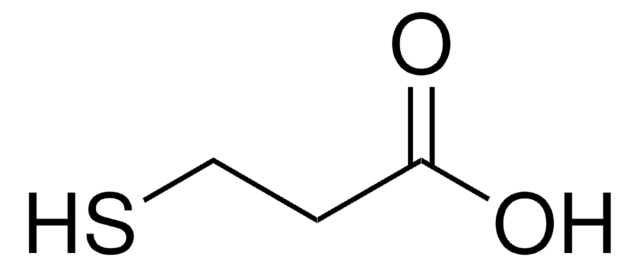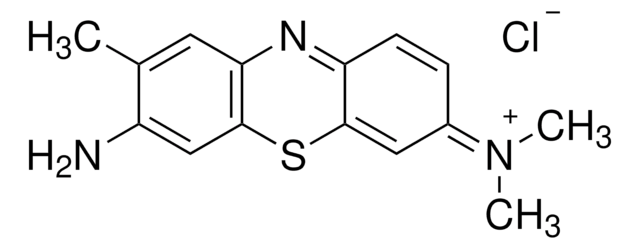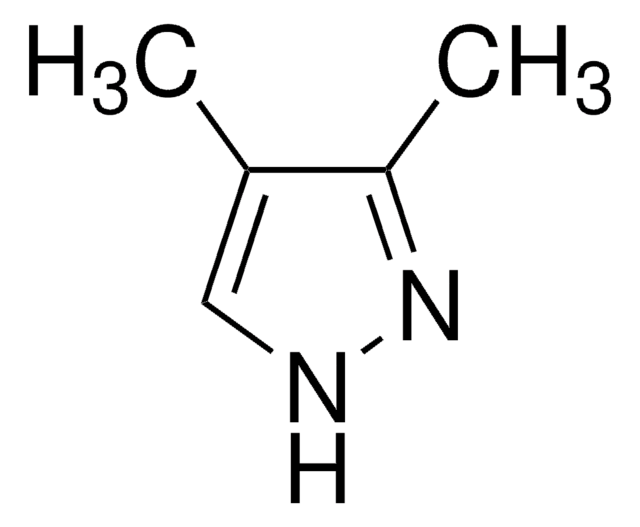D8016
Sodium 2,3-dimercaptopropanesulfonate monohydrate
95%
Sinonimo/i:
2,3-Dimercaptopropanesulfonic acid sodium salt monohydrate, DMPS
Autenticatiper visualizzare i prezzi riservati alla tua organizzazione & contrattuali
About This Item
Formula condensata:
HSCH2CH(SH)CH2SO3Na · H2O
Numero CAS:
Peso molecolare:
228.29
Beilstein:
3734863
Numero CE:
Numero MDL:
Codice UNSPSC:
12161900
ID PubChem:
NACRES:
NA.25
Prodotti consigliati
Descrizione
zwitterionic
Livello qualitativo
Saggio
95%
Stato
powder
PM
228.29 g/mol
Punto di fusione
215 °C (dec.)
Temperatura di conservazione
2-8°C
Stringa SMILE
O.[Na+].[O-]S(=O)(=O)CC(S)CS
InChI
1S/C3H8O3S3.Na.H2O/c4-9(5,6)2-3(8)1-7;;/h3,7-8H,1-2H2,(H,4,5,6);;1H2/q;+1;/p-1
XMUHNMQFDVIWGU-UHFFFAOYSA-M
Cerchi prodotti simili? Visita Guida al confronto tra prodotti
Categorie correlate
Descrizione generale
Sodium 2,3-dimercaptopropanesulfonate monohydrate is a chelating agent for heavy metals.
Applicazioni
Sodium 2,3-dimercaptopropanesulfonate monohydrate has been used in a study to assess its use as an antidote against non-metallic pesticides as nereistoxin insecticides. It has also been noted in a review of existing chelating agents for the treatment of heavy metals and metalloid intoxication.
Codice della classe di stoccaggio
11 - Combustible Solids
Classe di pericolosità dell'acqua (WGK)
WGK 3
Punto d’infiammabilità (°F)
Not applicable
Punto d’infiammabilità (°C)
Not applicable
Dispositivi di protezione individuale
Eyeshields, Gloves, type N95 (US)
Scegli una delle versioni più recenti:
Possiedi già questo prodotto?
I documenti relativi ai prodotti acquistati recentemente sono disponibili nell’Archivio dei documenti.
I clienti hanno visto anche
Santiago Iglesia-Turiño et al.
Plant physiology, 142(2), 742-749 (2006-08-22)
The mercury (Hg) accumulation mechanism was studied in rape (Brassica napus) plants grown under a Hg concentration gradient (0 microm-1,000 microm). Hg mainly accumulated in roots. Therefore, the presence of phytochelatins (PCs) was studied in the roots of the plants.
Swaran J S Flora et al.
International journal of environmental research and public health, 7(7), 2745-2788 (2010-08-19)
Chelation therapy is the preferred medical treatment for reducing the toxic effects of metals. Chelating agents are capable of binding to toxic metal ions to form complex structures which are easily excreted from the body removing them from intracellular or
Sodium dimercaptopropane sulfonate as antidote against non-metallic pesticides
Chen, Z., et al.
Acta Pharmacologica Sinica, 25, 534-534 (2001)
Holger A Scheidt et al.
Biophysical journal, 109(3), 586-594 (2015-08-06)
Many proteins are anchored to lipid bilayer membranes through a combination of hydrophobic and electrostatic interactions. In the case of the membrane-bound nonreceptor tyrosine kinase Src from Rous sarcoma virus, these interactions are mediated by an N-terminal myristoyl chain and
Christy C Bridges et al.
Toxicology and applied pharmacology, 285(2), 110-117 (2015-04-15)
Secretion of inorganic mercury (Hg(2+)) from proximal tubular cells into the tubular lumen has been shown to involve the multidrug resistance-associated protein 2 (Mrp2). Considering similarities in localization and substrate specificity between Mrp2 and the breast cancer resistance protein (Bcrp)
Il team dei nostri ricercatori vanta grande esperienza in tutte le aree della ricerca quali Life Science, scienza dei materiali, sintesi chimica, cromatografia, discipline analitiche, ecc..
Contatta l'Assistenza Tecnica.